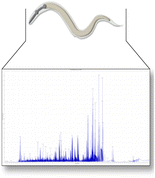A <Emphasis Type="Italic">Caenorhabditis elegans</Emphasis> Mass Spectrometric Resource for Neuropeptidomics |
| |
| Authors: | " target="_blank">Sven Van Bael Sven Zels Kurt Boonen Isabel Beets Liliane Schoofs Liesbet Temmerman |
| |
| Institution: | 1.Animal Physiology and Neurobiology, Department of Biology,KU Leuven (University of Leuven),Leuven,Belgium |
| |
| Abstract: | Neuropeptides are important signaling molecules used by nervous systems to mediate and fine-tune neuronal communication. They can function as neurotransmitters or neuromodulators in neural circuits, or they can be released as neurohormones to target distant cells and tissues. Neuropeptides are typically cleaved from larger precursor proteins by the action of proteases and can be the subject of post-translational modifications. The short, mature neuropeptide sequences often entail the only evolutionarily reasonably conserved regions in these precursor proteins. Therefore, it is particularly challenging to predict all putative bioactive peptides through in silico mining of neuropeptide precursor sequences. Peptidomics is an approach that allows de novo characterization of peptides extracted from body fluids, cells, tissues, organs, or whole-body preparations. Mass spectrometry, often combined with on-line liquid chromatography, is a hallmark technique used in peptidomics research. Here, we used an acidified methanol extraction procedure and a quadrupole-Orbitrap LC-MS/MS pipeline to analyze the neuropeptidome of Caenorhabditis elegans. We identified an unprecedented number of 203 mature neuropeptides from C. elegans whole-body extracts, including 35 peptides from known, hypothetical, as well as from completely novel neuropeptide precursor proteins that have not been predicted in silico. This set of biochemically verified peptide sequences provides the most elaborate C. elegans reference neurpeptidome so far. To exploit this resource to the fullest, we make our in-house database of known and predicted neuropeptides available to the community as a valuable resource. We are providing these collective data to help the community progress, amongst others, by supporting future differential and/or functional studies. |
| |
| Keywords: | |
| 本文献已被 SpringerLink 等数据库收录! |
|

